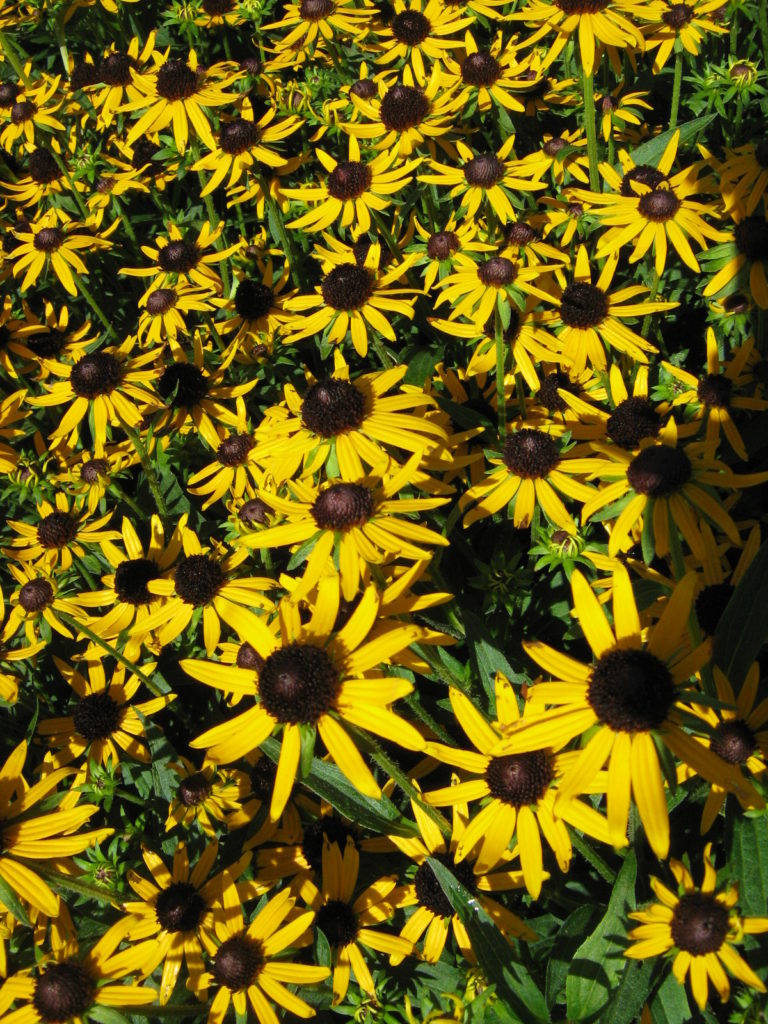Keep your late-summer garden looking fantastic with these tips for your August Garden.
1. Divide Perennial Flowers
August is the best time to dig and divide perennials in your garden, especially those that are done blooming for the season. Hosta, Papaver (Oriental Poppy) Lilium and Hemerocallis (Lilies and Daylilies), Iris germanica (German or Bearded Iris), cool season Grasses, such as Calamagrostis.
Using a spade or garden fork, lift the plant from the ground being careful to damage the root ball as little as possible. When the clump is out of the ground, use a large garden knife, spade or even your hands, to cut or break it into smaller pieces. Then, replant the smaller pieces or divisions as soon as possible. August weather can still be hot. Yes, it’s not called the Dog Days of Summer for nothing, so plant when there is a cool break in the weather, or just before a thunderstorm. And make sure to keep those newly divided plants well-watered.
FYI: Some perennial flowers such as bearded iris and ornamental grasses have a tendency to die out in the center. When you divide these perennials cut around the centers and toss the dead tissue on your compost pile.
2. Add Fall Color
Give your flower border a late-summer boost of color. This is the time to add Asters, Sedum, Perovskia, Agastache, Rudbeckia, Violas, and cool season grasses. Plus, because they are sold in bud or bloom, they’ll add instant impact to pots, planters, or flower borders. Their nectar-rich flowers attract a variety of colorful pollinators including migrating Monarch butterflies.
FYI: If you want Chrysanthemums or Mums to overwinter in Wisconsin, they should be planted earlier in the season. June and early July are ideal. Mums take a long time establish, so planting them early allows their roots to get a good hold and be able to handle our cold winters.
3. Replace Annual Flowers
By late summer, some annual flowers may look a bit worn out. Give your pots and planters a makeover by tucking in fresh, ready-to-bloom cool-season annual flowers that will keep the color show going through the fall. Just gently pull out dead or dying annuals, mix in a bit of fresh soil, and drop in the replacement. It’s that easy! Chrysanthemums, referenced above, would fall into the category of Annual flowers if planted now.
FYI: Be creative when you select replacement annuals. It’s your chance to experiment with something you’ve never grown before to see how you it performs for you.
5. Wage War on Weeds
Hopefully you’ve been able to keep up with weeding chores. BUT…If you’ve been putting it off, August is the time to finally get busy. That’s because, as the growing season winds down, both annual and perennial weeds start to produce thousands of seeds that will germinate in your garden next spring. If left unchecked, these pesky invaders become extremely difficult to eliminate. The best time to weed is right after a rain when the soil is still moist. If rainfall is scarce, irrigate your garden thoroughly the night before you start your attack. You can pull weeds by hand or use a hoe. Just be sure to remove the roots. Weeds such as crabgrass or purslane quickly regenerate from any root left in the soil. As soon as you have the weeds removed, cover the area with a thick mulch of compost, straw, leaves, or shredded bark.
FYI: Always maintain a sharp edge on your weeding tools. Keep a file handy and sharpen your hoe every time you work. The sharper the blade the faster you’ll get the job done and the easier it will be.
6. Plant Perennials and Shrubs
Late summer is a perfect time to plant perennials and flowering shrubs. They’ll take root during the cool, moist fall weather and be ready to pop into bloom next spring and summer. Some good candidates to plant now include any perennials that bloom in April, May, and June. Be sure you keep your new plants well-watered if the weather is hot and dry. Mulching the beds also helps preserve soil moisture. In northern states, cover new plantings with a protective blanket of straw or leaves during their first winter. Wait until the ground freezes in late autumn before covering.
FYI: Store plant tags in a safe place so that next spring you’ll be able to identify your perennials as they break dormancy.
7. Water Evergreens
If rainfall is scarce be sure to keep evergreen trees and shrubs hydrated. Because plants such as yew and arborvitae never go completely dormant, their roots should be slightly moist to help the plant survive drying winter winds, especially if you live in the North. If you start watering evergreens now, they will have plenty of soil moisture around their roots before freezing temperatures make irrigation impossible. Newly planted evergreens are particularly susceptible to dry soil so make sure they get at least an inch of water a week.
FYI: Soaker hoses are a great way to irrigate newly planted evergreens. The hose allows water to seep slowly into the soil so there’s no wasteful runoff.
9. Consider Fertilizer
Northern gardeners should stop feeding roses, trees, shrubs, and perennial flowers now. Feeding your plants in the late summer and fall encourages new growth that probably won’t survive the winter. By putting your plants on a diet now, they’ll toughen up before freezing temperatures hit.

